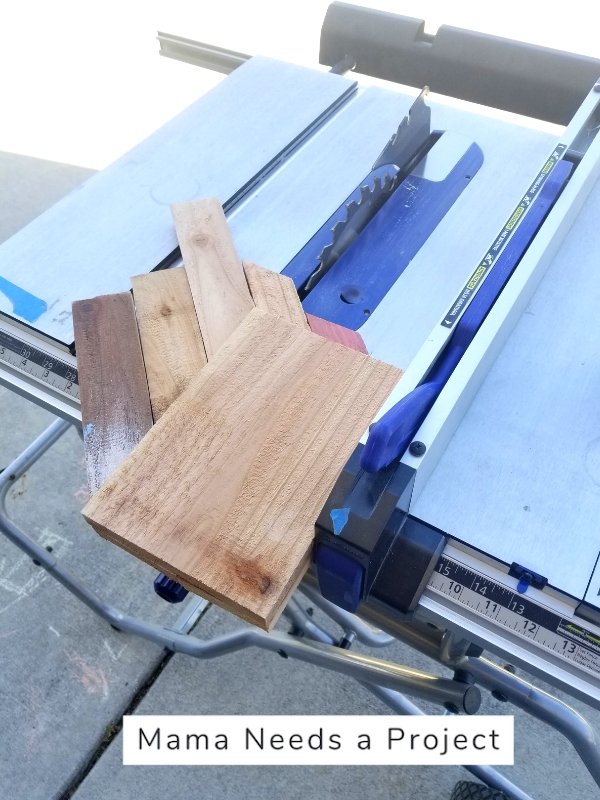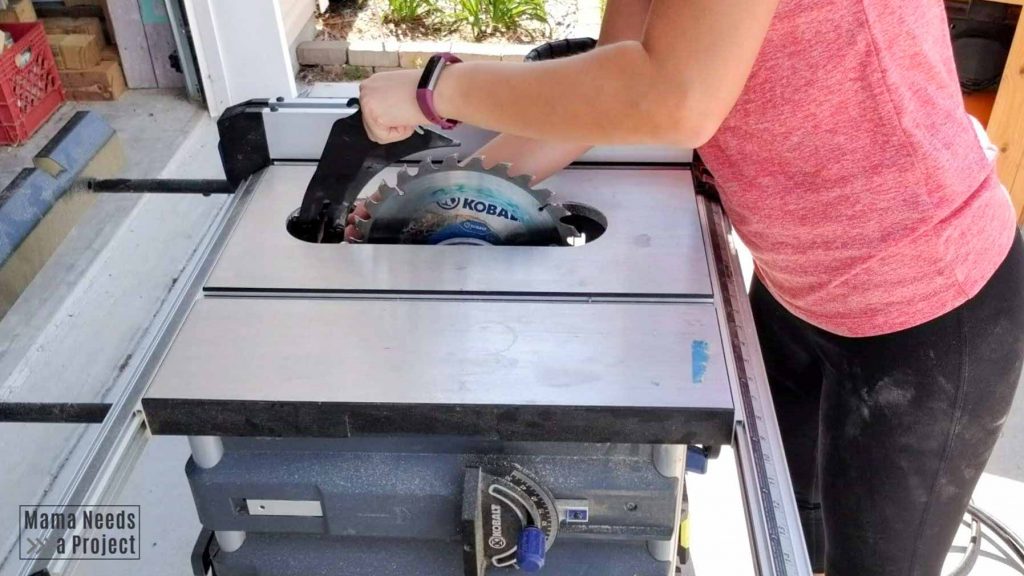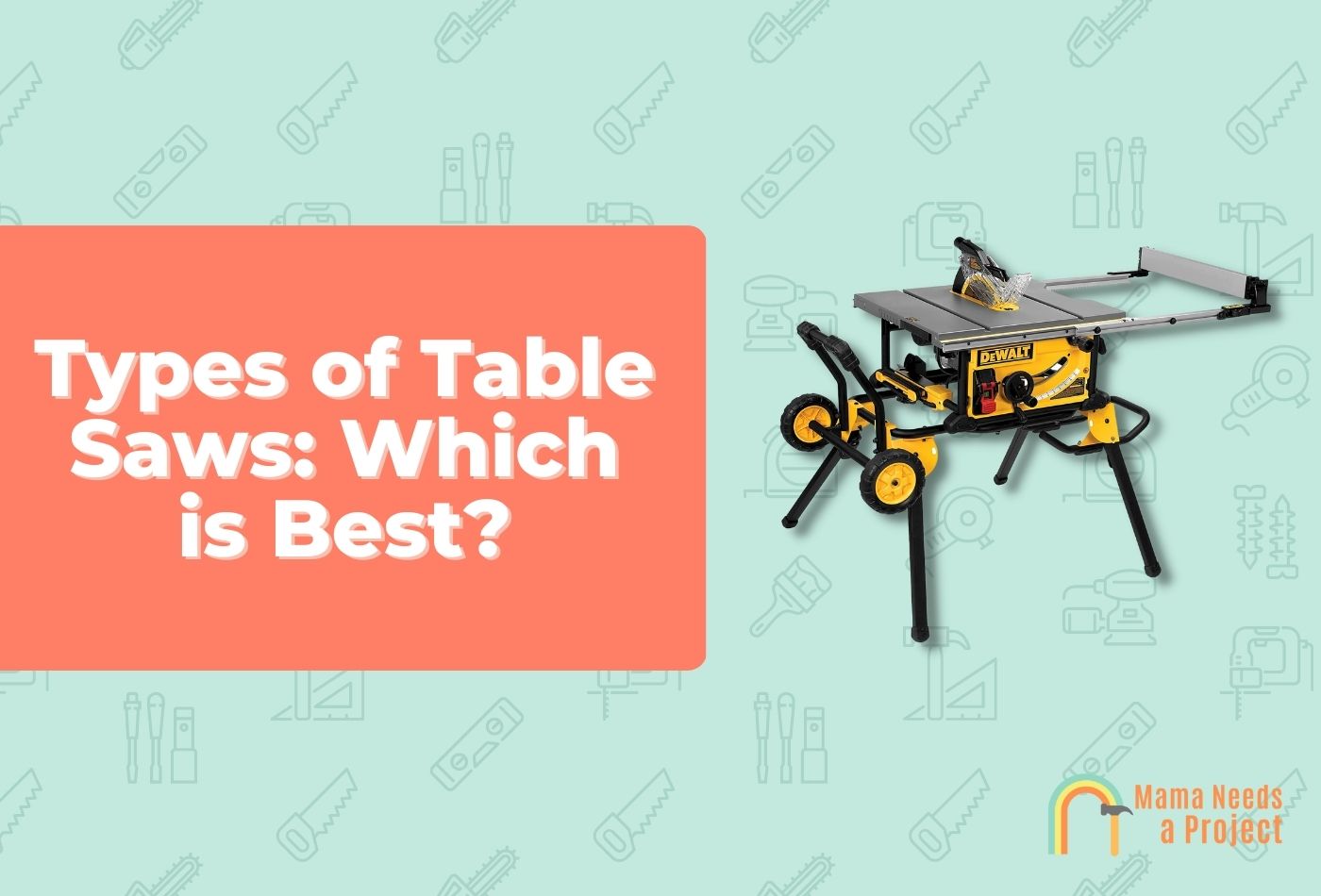Types of Table Saws: Which is Best? (Ultimate Guide)
Table saws are some of the best tools for making long, accurate cuts, at a production pace. Once you adjust the fence to the proper distance from the blade, you can feed board after board across the blade with extreme precision and speed.
As is the case with most tools, however, there are many different types of table saws. Some table saws can cost thousands, while you can find some table saws under $1000 – so there’s no shortage of options.
In this post, I’ll explore the different types of table saws, the pros and cons of each type, and what projects it’s most useful for. Let’s dig in!
Benchtop & Portable Table Saws
Benchtop and portable table saws are all about convenience.
These models are compact and useful for DIYers and homeowners who only need a table saw every once in a while. They’re small enough that they can fit on top of a workbench or portable work table when in use, or on a shelf when they’re not in use.
Since benchtop and portable table saws need to be easy to move around, they feature lightweight materials and parts. For example, most of these table saws have smaller motors with power outputs under 2 horsepower. These motors are typically direct-drive, which means the blade attaches directly to the motor. They might also feature plastic bodies and thin aluminum parts. This is the trade-off of the benchtop and portable table saw: long-term durability for portability.
Benchtop table saws use 120-volt electricity, meaning they can plug into most standard outlets. They often use 8.25-inch blades, which are smaller than most full-size table saws.
Looking for a beginner table saw? Check out these best table saws for beginners!
Who Are Benchtop and Portable Table Saws For?
Benchtop and portable table saws are a great choice for light-duty projects, like ripping softwoods like pine and fir, and even thinner hardwoods (¾-inch-thick is typically fine).
However, for larger or denser woods, the blades may slow down, burn the side of the wood slightly, or stop altogether. Also, since all of the parts are generally light-duty, these saws don’t offer the same level of accuracy as others types of table saws.
Jobsite Table Saws

Jobsite table saws are larger and heavier-duty than benchtop or portable table saws, but they’re still designed to be mobile and relatively compact. They’re often attached to wheeled stands that contractors (or DIYers) can roll back and forth from the truck (or garage) to the actual location of the work taking place. They have wider tables, longer fences, and bigger 10-inch blades, but they’re essentially a scaled-up, heavier-duty version of the portable table saw.
Jobsite table saws contain most of the same materials as portable table saws (aluminum and plastic), but with thicker, more durable construction. Their bases are typically designed with holes for mounting hardware, allowing users to attach them directly to rolling stands for easy transport. Also, motors are almost always direct-drive, allowing users to place these saws in a truck, roll them up or down stairs, or just take the general rigors of a job site without worrying about belts and motor alignments. Direct drive motors also keep jobsite saws as light as possible, and they run on 120-volt electricity.
Who Are Jobsite Table Saws For?
Job site saws are an excellent choice for construction sites and large DIY projects. They can rip through dense framing lumber, but they’re also stable enough to pass a large sheet of plywood across if needed. They’re not as accurate as true contractor or cabinet saws, but they’re a handy option for someone who needs portability and durability.
Contractor Table Saws

Contractor saws are the next step up from jobsite saws in the table saw hierarchy.
These saws are larger, more heavy-duty, and sometimes more powerful but less portable than a jobsite saw. Unlike jobsite saws, these models often have belt-drive systems where the motor hangs off the back of the saw and attaches to the blade’s spindle via a rubber belt.
Usually, contractor saws feature an open-leg design with wheels on the bottom of the legs. This design enables users to roll them around small workshops and position them wherever they need them (a handy feature for cutting sheet goods). They typically contain heavy-duty steel and their tables and fences are more durable and accurate. They commonly use 10-inch saw blades and 120-volt electricity.
In the market for a contractor table saw? Check out my list of the best contractor table saws you can buy!
Who Are Contractor Saws For?
Despite their name, contractor table saws rarely make it to project sites these days. Instead, this type of table saw is becoming more popular for professional workshops and serious DIYers. They have plenty of power to cut most materials, and their fences are accurate. However, they’re too heavy to be wheeling back and forth to the project site, so if they are used on a job site, they’re often left there for the duration of the project.
Cabinet Table Saws
Cabinet table saws are the type of tool that a shop is built around.
They have wide surfaces and long fences, and they can accommodate wide sheets of plywood used for building large woodworking projects, cabinets, and special furniture. However, they’re not called “cabinet saws” because they’re only used in cabinet building; these saws have enclosed bases that resemble cabinets, and they house all of their moving parts inside to improve dust collection, protect moving parts, and reduce noise.
These large, powerful saws are very heavy (usually several hundred pounds) and provide the utmost accuracy compared to the other types of table saws. They use 10-inch blades and are made from steel and cast iron, reducing vibration, increasing stability, and allowing them to stay as accurate as possible for as long as possible. Their parts are also overbuilt, allowing these saws to operate every day for several hours for a long time before requiring service.
A cabinet saw blade is usually driven by a belt attached to a large motor inside the cabinet. They typically have around 3 to 5 horsepower, allowing them to cut through thick stock and hardwoods. These motors use 220-volt power, as well, which requires a special electrical service run to the shop in most cases.
These saws will have the largest rip capacity when compared to other table saws.
Who Are Cabinet Table Saws For?
Cabinet saws are likely too large and too expensive for the average DIYer, but for a professional woodworking shop, they’re indispensable. These pros will typically set them up in the center of the shop, run dust collection to the saw, and use it for hours on end, ripping down sheets of plywood into usable pieces for cabinetry and furniture construction.
Need more accuracy from your table saw? Check out these best table saw fence systems!
Hybrid Table Saw
A hybrid table saw is essentially a meet-in-the-middle of a contractor saw and a cabinet saw.
They have wide worktops, half-enclosed or open cabinets, and a bit more portability than a standard cabinet saw. While they’re heavier than a contractor saw, they’re lighter than a cabinet saw. They also use 120-volt electricity, meaning most garages have the proper power to operate them, and they’re more affordable than cabinet saws.
Hybrid table saws are generally very accurate and built from high-quality materials that can last for decades if cared for. They have wide worktops and long fences for improved accuracy and capacity.
Who Are Hybrid Table Saws For?
Hybrid table saws are one of the most versatile of the bunch, where almost anyone can use them, whether you’re a beginner or experienced woodworker.
If you want to make miter cuts with your table saw, check out these top rated table saw miter gauges!
Cordless Table Saws
Cordless table saws are relatively new, as it wasn’t until the last few years that battery and motor technology improved enough to make them a reality.
These saws are compact and easy to transport, and they’re generally much smaller than a typical saw (even smaller than a benchtop model). They can weigh as little as 30 pounds without a battery, making them easy to place on top of a workbench or in the bed of a truck for transport.
Cordless table saws are designed with portability in mind, so they usually contain materials such as plastic and aluminum. Their worktops are small and their fences are short, making them less than ideal for breaking down large sheets of plywood or wide boards. They have direct-drive motors, as well, and they usually use 8 ¼-inch saw blades.
Who Are Cordless Table Saws For?
Cordless table saws are a great choice for DIYers, contractors who only use their table saw occasionally, and folks already invested in a slew of brand-specific batteries. They are a bit more expensive than a standard benchtop or portable table saw, and they may not come with batteries, so there is an additional expense related to these handy tools.
Table saws can cut all kinds of materials including plexiglass, metals, plastics, and woods.
Final Thoughts
In the end, choosing a type of table saw comes down to your most common project types and needs. Do you need something portable? Then a cordless or benchtop model might be best. Are you designing their dream workshop? Maybe a cabinet saw or contractor saw will do the trick. Do you need to get a saw to a new project location every few days? Then a jobsite saw is the way to go.
Once you decide the type of table saw that will work best for their needs, you can start comparing models based on their features, materials, and specifications to find the best one for you.

Tom Scalisi is a freelance writer, blogger, published author, and website owner with over 20 years of experience in the trades, DIY, and construction. Today, he’s mostly hung up his professional tool belt (though he’ll still tackle a DIY job every now and then) for writing, as he loves teaching DIYers how to accomplish their goals and get the job done.
Tom has written for some of the industry’s most popular websites, including Bob Vila, This Old House, The Family Handyman, and Forbes.
Outside of work and the internet, Tom is a husband and father of four. He loves baseball, whether it’s catching a game live or on TV, or coaching one of the many recreational or travel teams he’s with which he’s involved. He also serves as the Director of Baseball for his local baseball and softball league.

